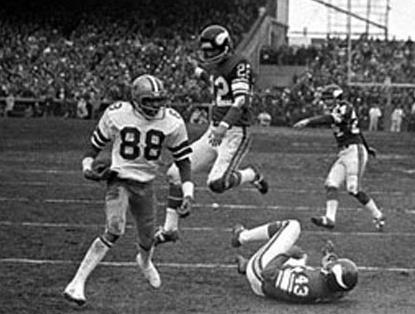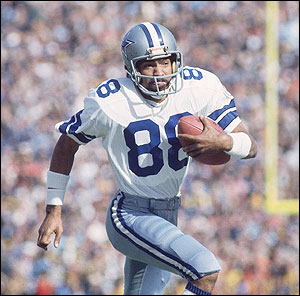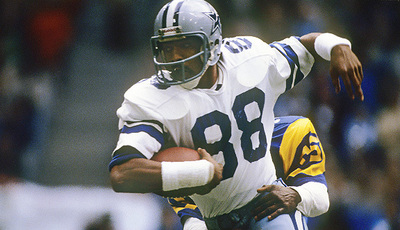Drew Pearson: Mr. Clutch
The January Sports Then and Now Vintage Athlete of the Month is one of the greatest clutch receivers in NFL history and a player whose exclusion from the Pro Football Hall of Fame is one of multiple horrible miscues made by the HOF selection committee.
During his decade with the Dallas Cowboys, Drew Pearson had a habit of making the big catch at the right moment to help the Cowboys time and again snatch victory from the jaws of defeat.
The favorite target of Hall of Fame quarterback Roger Staubach, Pearson was widely recognized as one of the great receivers of his era. Though at the time of his retirement many expected Pearson to easily breeze into the Hall of Fame, his enshrinement was derailed by changes to the game which artificially inflated receiver stats and made the numbers he produced during a time when wide receivers weren’t catching 100 passes a season seem inferior.
Ironically, the reality is the exact opposite as though Pearson (and other top receivers from his era) didn’t catch as many passes as the top receivers of the current NFL, the catches he did make were usually crucial to helping the Cowboys become perennial Super Bowl contenders.

Drew Pearson was on the receiving end of the “Hail Mary” from Roger Staubach in the 1975 NFC Playoffs.
Signed by the Cowboys as an undrafted free agent out of Tulsa in 1973, Pearson, who had started his college career as a quarterback before transitioning to receiver, quickly became a key weapon for the Cowboys.
As a rookie, Pearson caught 21 passes for 373 yards during the final six games of the regular season to become a favorite target of Staubach. He caught five passes for 140 yards and two touchdowns in the regular season finale against the St. Louis Cardinals and the next week caught two passes for 87 yards and two scores in a playoff victory over the Los Angeles Rams.
Even though the 1974 season would be the only season during his career that the Cowboys didn’t reach the playoffs, Pearson posted what would prove to be the best statistical season of his career as he registered career-highs with 62 catches and 1,087 yards to earn first team All-Pro honors and his first Pro Bowl appearance.
It was on Thanksgiving Day in 1974 that Pearson started to develop his reputation as a clutch receiver. With the Cowboys trailing the Washington Redskins in the final minutes and backup quarterback Clint Longley in the game for an injured Staubach, Pearson raced past a Washington defender and caught a 50-yard touchdown pass to lift the Cowboys to a 24-23 victory.
Dallas returned to the playoffs in 1975, but was trailing the Minnesota Vikings 14-10 in the final minute of their opening playoff game. Pearson made a crucial fourth-down reception to keep their drive alive and then hauled in a 50-yard touchdown pass that became known as the “Hail Mary” to lift Dallas to victory. Though Dallas lost Super Bowl X to the Pittsburgh Steelers 21-17, Pearson had a 29-yard touchdown pass and caught two passes for 59 yards in the game.
To illustrate just how different the game was for receivers in the 1970s, Pearson led the NFL with 58 catches in 1976 and the following season led the entire NFL with 870 receiving yards in the final year of the 14 game regular season. He was a first team All-Pro and Pro Bowl selection in each season.
The Cowboys returned to the Super Bowl in 1977 and Pearson had seven receptions for 113 yards in their three playoff victories.
Pearson eclipsed the 1,000 receiving yard mark for the second time during his career in 1979 as he caught 55 passes for 1,026 yards and eight touchdowns.
With Danny White serving as the Dallas quarterback in 1980, Pearson caught a pair of fourth quarter touchdown passes to lift the Cowboys to a 30-27 comeback victory over the Atlanta Falcons in the second round of the NFC Playoffs.
Dallas reached the NFC Championship Game following the 1980, 1981 and 1982 seasons, but was unable to return to the Super Bowl.
In the 1981 NFC Championship Game, Pearson came within a finger-tip of forever securing his place in history as football’s ultimate clutch receiver. With the Cowboys trailing the San Francisco 49ers 28-27 in the final minute, Pearson caught a Danny White pass near midfield and momentarily broke free for what could have been a game-winning touchdown. However, cornerback Eric Wright was able to grab Pearson’s shoulder pad and jersey with one hand and haul him down after a 31-yard catch. White fumbled on the next play to end the threat and lift the 49ers to the Super Bowl.
For his career, Pearson appeared in 22 playoff games and caught at least one pass in each contest. He caught 67 passes in those games for 1,105 yards and 8 touchdowns.
Injuries suffered during a car accident in early 1984 ended Pearson’s career after 11 seasons. He finished his career with 489 regular season receptions for 7,822 yards, 16 yards per reception and 48 receiving touchdowns.
Unfortunately for Pearson, the 1984 season marked the beginning of the “super-sizing” of receiver statistics as Art Monk of the Redskins set an NFL record with 106 receptions. Since that time, the 100 reception mark has been eclipsed 74 times. Though Pearson ranked in the top 20 in receptions and receiving yards at the time of his retirement, he is now 126th all-time in receptions and 89th in receiving yards.
Hopefully at some point the Hall of Fame voters will recognize that being a great receiver is about more than statistics and honor a deserving receiver who made a career of being Mr. Clutch.











